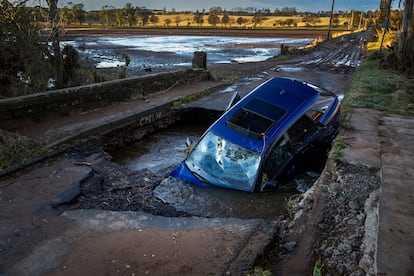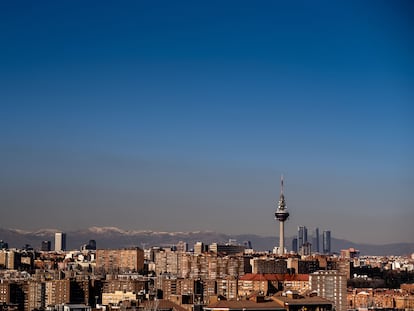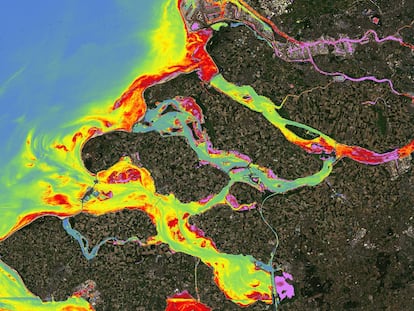Rainwater in cities causes more troubles than wet feet
Researchers are looking at how to tackle pollutants in urban runoff and overflowing sewers

Near the medieval Belgian city of Ghent, in the municipality of Wetteren, researchers are trying to reduce pollutants in rainwater using seashells.
Millions of shells from the nearby North Sea collect and filter water that flows during rainfall from a shopping-mall roof and a parking lot.
Stormwater challenge
The shells, amassed below a surface drain, have a 70% hollow space that allows them to store a heavy downpour. They’re also a natural cleansing station for the water, which is then used to irrigate communal gardens.
The experiment is part of a research project called StopUP that received EU funding to come up with new ways to prevent stormwaters from carrying pollutants into rivers, lakes and bays.
The project’s focus is on urban runoff — rainwater that accumulates pollutants from streets, rooftops and other places as it washes through cities — and on overflowing sewers. The goal is to ensure that such wastewater, which can contain everything from plastics to pesticides, gets treated.
“StopUP technologies and methods could provide tools that practitioners use to plan and implement measures to reduce stormwater pollution,” said Professor Thomas Wintgens, head of the Institute of Environmental Engineering at RWTH Aachen University in Germany.
Wintgens coordinates StopUP, which began in September 2022 and is due to run through August 2025.
While 98% of people in the EU have access to basic sanitation services and more than 90% of urban wastewater is handled in line with European legislation dating to 1991, contamination remains a big challenge.
In Europe, 38% of surface waterbodies have various forms of pollution, according to the European Environment Agency.
Pollution tracks
Human health depends on clean water for drinking, bathing and cooking. The health of the ecosystem is also at stake because plants and animals are affected by chemicals in rivers, lakes and coastal waters.
“While a lot of progress has been made on wastewater treatment in the EU, the impact of residual emissions coming from urban runoff and sewer overflows is important,” said Wintgens.
In collaboration with 11 universities and companies from Belgium, Germany, Italy, the Netherlands, Norway, Switzerland, Tunisia and the U.K., StopUP is developing technologies to improve understanding about where pollutants come from and how they get into waterbodies. Typical pollutants include nutrients, hydrocarbons, heavy metals and microbial contaminants.
In the German city of Aachen near the Dutch and Belgian borders, StopUP is testing a sand-based filtration system to curb pollution from sewer overflows into the river Wurm. The technique being deployed — called a “retention soil filter” — consists mainly of sand with a bottom drainage layer of gravel and reeds planted on the surface.
In Antwerp, Belgium’s second-largest city after Brussels and ahead of Ghent, the researchers are experimenting with a gravel filter to treat urban runoff.
“This is an important field of research — very relevant for communities and the environment,” said Wintgens, who has two decades of experience in water management and wastewater treatment.
Squirming in the rain
Luz Herrero is another expert in this field.
Head of environmental technology at AIMEN Technology Centre near Vigo in western Spain, she coordinates a separate EU-funded project to tackle water runoff in cities.
Called WATERUN, it is scheduled to last for four years through May 2026.
Herrero, who has worked on technologies to tackle environmental challenges for the past 18 years, said a big gap can exist between popular perceptions of rainwater and its true composition.
“It may seem that rainwater is very clean, but when it washes the streets and roofs it becomes loaded with dust, residues of animal feces, microplastics and other toxic pollutants,” she said. “Diffuse pollution can have significant negative impacts on human wellbeing and ecosystem health.”
For instance, health costs in Europe associated with the presence of nitrate — a chemical often used as a fertilizer — in drinking water exceed €1 billion a year, according to the Organisation for Economic Cooperation and Development.
Herrero said a “knowledge gap” exists about where exactly the pollution originates and how it is spread through water.
In response, WATERUN is developing sensors for polycyclic aromatic hydrocarbons (PAHs) — chemicals from coal, oil and petrol — to be placed in urban catchments. It’s also seeking to identify the source and distribution of pollutants.
The project is carrying out on-the-ground studies in three cities with very different climates: Aarhus in Denmark, Santiago de Compostela in Spain and Amman in Jordan.
The three cities are also at different stages of action, with Aarhus the frontrunner and Santiago de Compostela still gearing up.
Aarhus, with nearby lakes, a river basin and a bay, is focusing on ponds in the city center. Its goal is to remove 70% of microplastics, phosphorus and PAHs, which can accumulate in the ground and damage soils, plants and animals.
“In Aarhus they have already put in place infrastructures to deal with urban water runoff,” said Herrero.
The WATERUN researchers plan to draw on the three case studies to produce guidelines for city authorities on how best to tackle urban runoff.
Climate influences
The research is even more important because of accelerating climate change, which is causing more frequent — and increasingly severe — storms and floods along with rising temperatures and worsening heatwaves.
“It can only exacerbate the problem due to changing precipitation patterns and extreme rainfall,” said Herrero.
Wintgens highlighted another climatic connection, saying droughts pose a challenge for the researchers themselves.
“If it doesn’t rain for months on a specific site, we cannot sample anything,” he said.
But the fundamental point is the importance of clean water.
“Let’s not forget about water quality,” Wintgens said. “It is crucial as it determines the quality of our common environment.”
Research in this article was funded by EU. This article was originally published in Horizon, the European Union Research and Innovation Magazine.
Tu suscripción se está usando en otro dispositivo
¿Quieres añadir otro usuario a tu suscripción?
Si continúas leyendo en este dispositivo, no se podrá leer en el otro.
FlechaTu suscripción se está usando en otro dispositivo y solo puedes acceder a EL PAÍS desde un dispositivo a la vez.
Si quieres compartir tu cuenta, cambia tu suscripción a la modalidad Premium, así podrás añadir otro usuario. Cada uno accederá con su propia cuenta de email, lo que os permitirá personalizar vuestra experiencia en EL PAÍS.
¿Tienes una suscripción de empresa? Accede aquí para contratar más cuentas.
En el caso de no saber quién está usando tu cuenta, te recomendamos cambiar tu contraseña aquí.
Si decides continuar compartiendo tu cuenta, este mensaje se mostrará en tu dispositivo y en el de la otra persona que está usando tu cuenta de forma indefinida, afectando a tu experiencia de lectura. Puedes consultar aquí los términos y condiciones de la suscripción digital.










































